Critical Correspondence
- 1 comment
- Conversations
- 7.7.09
Megan Byrne, Michael Mahalchick, Will Rawls, and Regina Rocke in conversation with Levi Gonzalez
MR Spring Festival 2009 – Roll Call
Download this interview as PDF
Levi González: I’m here with the Movement Research Festival Curatorial Team from Spring 2009 – Roll Call: Regina Rocke, Will Rawls, Michael Mahalchik and Megan Bryne. I’m curious about what your ideas of the Festival were and why it was of interest to you to be a curator this year.
Megan Byrne: I think that we all had some participation in last year’s Spring Festival. The momentum from that was definitely a motivation for me – I had such a good experience last year – and also participating in other festivals like Impulstanz and Springdance. Having an opportunity to bring what you’ve experienced there to New York was a really nice opportunity.
Will Rawls: The invitation was very open-ended. There were three parameters: workshops, performances and studies projects. Other than that it was do whatever you want, which is very trusting. So you can make your bed and figure it out as you go. And you have some support.
Regina Rocke: I think they’ve summed it up. There wasn’t a reason to say no for me.
Levi: Last year’s Festival, Somewhere Out There, was the first year they started asking artists who weren’t necessarily self-identified dancers or choreographers, but who had a relationship to the community, to join the team….which sort of characterizes your [to Michael] participation. What is it like to curate something that is ostensibly a dance festival? Did you feel like you had a particular angle on moving it beyond just the dance world?
Michael Mahalchick: I have to say that being in the art world is not that different than being in the dance world in terms of creating art works. So, it doesn’t seem like such a crazy stretch to me, really.
Regina: And we all had an artistic vision. I don’t think that any of us went in wanting a lot of dance.
Michael: It’s funny because I’ve curated performance nights before and I always had dance involved. I never made a huge distinction between the practices. I don’t think it’s such a dramatic jump. I guess performance art has a permeable membrane as to what is allowable or what is interesting. I wanted to involve people who weren’t necessarily so involved in the dance world, people that are more art world, trying to get a little more blend. There already is, but I always feel like there’s opportunity for conversations that don’t happen between those two worlds.
Will: And there are a lot of people who do consider the dance, the visual and the performance worlds different worlds that draw on different influences, which isn’t true! [To Michael] I think you’re an exception. But we were also talking about the recession. We got this gig right when the shit was hitting the fan economically, when things were sliding uncontrollably off the cliff. So we were also thinking a lot about how to address the recession. I think contemporary dance and contemporary performance in general is a form that is constantly considering what’s happening now in relation to history or the future. It’s very concerned with the present. For me that was definitely a motivating factor-making this Festival be really conscious of the presence or lack of money. That this is going to be the future of art for the next five years…
Regina: And looking back on it I realized that I didn’t really have a lot of money to begin with-my life hasn’t changed too much. The people hit hardest are the ones used to getting $10,000 grants from the NEA or whatever, people who have more established companies or organizations. The biggest reality check was that some of the galleries [we were working with] closed while we were coordinating the Festival. Once [the Festival] started, I started to focus on what happened [in performance]. The things that come to mind are distinct events that we had. But we did start by thinking a lot about the economy.
Levi: In general most artists in this economy are thinking “Oh, now other people have to live the way that we’ve been living for the last 20 years.” Artists have always been able to maximize their resources with limited means.
Regina: I feel like the art world has been hit more than the dance world.
Michael: Well, yea, you guys never had any money…(laughter)
Levi: There’s money there to be lost…
Michael: I’ve been noticing a lot more people performing in galleries. I’m not saying that the Festival had anything to do with that, but I think galleries aren’t selling so much, and are starting to feel like maybe its not what collectors are buying, but the atmosphere of the gallery, you know?
Megan: To have a performance brings new traffic. I have a friend who has a gallery and she’s started making that a regular thing where she’s scheduling one day in-between shows when she has a performance, and instead of the performer having to work within whatever art work is being shown, they can do whatever they want in the space. It’s a really nice opportunity.
Regina: If you’re going to limit yourself to only doing a show in the theater at a more major venue, then that’s a lot of waiting and hoping. There’s a lot more opportunity to perform your work and have it seen in the gallery venue. There are tons of galleries in New York and in Brooklyn, where you can have 5 shows a year instead of waiting for that one show at The Kitchen or wherever. And you just approach them a lot of time. Sometimes they’ve seen your work and then they ask you to perform. But I know a lot of people who just walked in and said “I want to have a show here.”
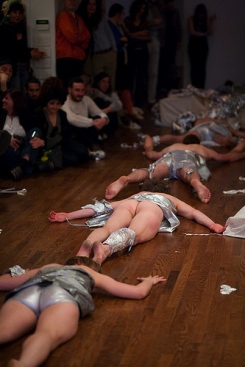
photo: Willie Davis
Megan: In all of our talks about economy and sustainability and recession and resource-sharing, I wish we could have paid the artists more. We had artists such as Walter Dunderville and how many performers did he have? Nine, ten? Those people all did it for free. He had tons of props. He probably had $50 worth of aluminum foil. Looking back I wish we could have paid those artists a living, working wage. That is the one thing that I’m almost disappointed in myself for the Festival, it’s one thing I wanted to do and it’s virtually impossible.
Regina: Where would you…? I mean where would we cut…?
Megan: Exactly!
Regina: Make it shorter?
Megan: I don’t know. This is a question for the future.
Will: We only had a small budget, and we could only pay so much, so the performers had to work with that budget. It would be nice to pay them more, but you’re also doing this as a celebration of the community of Movement Research, of this dance community, where maybe you sacrifice a little because of the idea of what the Festival is.
Megan: Yeah, but overall, that “excuse”, for lack of a better word, is being used in every performance opportunity across the board. Where is the change? New York City deserves a competitive festival and it has the artists here, and opportunities to showcase performers and work in ways that no other festival can. I just hope for the future that there’s change in performance across the board in New York!
Will: The way that [the MR Festival is] set up is they have four people who’ve never curated a festival before. So we all have 55,000 ideas, we come, we mash them all together, they fall apart, we try it again and again, and we’re running out of time, we’re figuring out how to get venues, and the being economical is just as much of a learning curve as the curatorial, creative, ethical, moral, whatever it is-other questions that you’re dealing with on your way.
Megan: I don’t know if we necessarily have the answer, but it’s the one thing that, to this day, still makes me uneasy.
Levi: I think it’s a huge question that you’re bringing up. It’s more of a long-term question about the situation we’re living in, in New York City, and how can we change it. And I think it’s relevant that it came up for you in light of being in the position of curator and being on the other end of that. It’s very instructive for artists to see how that end of it functions and what choices are possible.
Megan: And also for artists to not be afraid to ask for more. The worse you can do is be told no, but by asking and asking early, even if it’s for an extra $25, there’s the potential to get it.
Levi: I want to pull back a little bit and talk about the vision for the Festival and how that developed? Did the vision precede the planning or did it develop as you were creating the events? Did the planning influence the overall vision of the festival?
Regina: I think we had a lot of the same ideas-we didn’t want to stay in one location…
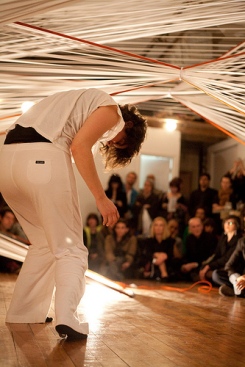
photo: Katie Dorn
Michael: I think we knew how little the budget was and tried to figure out how to stretch this money as far as it can go. That, if anything, was a determining factor in how things functioned. How do we stretch this money to have the most impact, I suppose, because it’s not a big budget really. Ours was nine or ten days of things. I’m not quite sure how they did two weeks the year before.
Will: And not stretch the audience too thin. One thing that was very important to us was building an audience for Movement Research. Finding outlets and access to people, and expanding. The idea of expansion was on my mind a lot and I think we kept a very close relationship between the idea of expansion and the idea of budgeting. We actually had a really tight back and forth between the two. We didn’t go over budget.
Megan: We broke even. But also we had those first two planning meetings and we pretty much nailed it-we were all on the same page right off the bat. We wanted to do gallery stuff, we knew we wanted to collaborate with other curators and the whole idea of resource sharing and economy, and then as soon as we nailed that down, we went running with it and started pitching it to whomever – anyone and everyone.
Will: You have to assume, curators, artists, choreographers… caterers, anyone that is peripherally or essentially related to producing or presenting work, is going to want to keep their hand in the pot somehow, to keep active somehow. So if you can have four people on one night, it makes a production more possible than getting several people working ten nights in a row. Asking a little bit of many different people was one of the strategies as well.
Megan: We also had one event per night, instead of multiple events throughout the day, to keep our attendance high. And both MR and CLASS had great classes going on at that time, so we just promoted them instead.
Regina: Yeah, we were all on the same page about that. We were not going to be workshop/class-heavy.
Will: It’s like building what’s already there into the Festival.
Levi: And maybe narrowing your focus so that it doesn’t have to be about doing everything?
Will: Although I do think some Festivals are really focused around, say, “the idea of conceptual art from 1960 to 1979” or something like that. Our festival is much more about a feeling. For me, it was a feeling we wanted to generate. Our events were so different from night to night. Roll Call, when we finally hit on that name, was really about this idea of attendance, of everyone is valid, whoever you know and I know and you know can somehow get in here. It wasn’t so much about making sure that there was a conceptually tight through-line for the festival, or an overwrought language about the festival. It was just getting that language up, sort of simple enough… for me it was very important to move away from really specific anatomical language that shows up in a lot of contemporary dance materials. I think it turns [some] people off. That doesn’t make that language any less valuable, but there’s a lot of people for whom that’s not the front door for coming to see a dance performance or understanding contemporary dance, or at least not the only way.
Levi: How influential, either by way of inspiration or by way of moving away from it, were previous Spring Festivals?
Michael: We carried one or two projects from the previous one to this one…
Will: 48 X 4 X 3…
Megan: and we took the idea of Recessional from…
Regina: oh, the Rampage! The Performance Rampage.
Levi: I see. And it mutated into something else…
Regina: I feel it’s natural to respond to the previous [Festival]. I definitely was thinking less, less, less. I got worn out from attending so much last year. My first response was, let’s make it shorter. And the gallery thing… let’s branch out and investigate some other possibilities, and feature some people who the dance community maybe doesn’t know about.
Will: Or wouldn’t think of asking.
Megan: But there was a lot of momentum from past Festivals also. Because past Festivals have gotten press, it was really easy to approach new venues. Past Festivals gave us clout to actually move really fast.
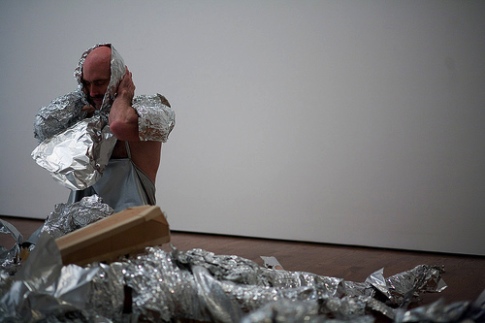
photo: Willie Davis
Levi: What do you think about inclusivity or exclusivity in terms of curating? And this is an issue that hovers around Movement Research as an organization anyways because it is an organization that doesn’t have an artistic director, that is ostensibly community-based, which makes things complicated in terms of how decisions are made. So, I’m curious how you approached it because curating essentially is about making choices or selecting people or work. And as artists I’m sure you’ve been on the other end of that.
Will: We did some open calls, we did things that weren’t curated necessarily or selective in that way… like you have to make a video dance piece, and then we looked at them, and I guess we did do some selections there-we didn’t show it all. But we made links and postings and things like that.
Michael: We got a lot of people who were kind of out there for the video portion of the thing, which was a little surprising. There’s a few visual artists that I talked to afterwards that had no idea that this was going on.
Regina: And we had a ton of people show up for that event at Monkey Town.
Michael: I think there were some bridges made on that. I think it reached people in a way that I wanted. There was a visual artist who was part of the gallery call, but she’d been vaguely interested in dance for a little bit, and then suddenly, she probably has been to every Monday night at Judson Church. She became engaged in a way that makes me very excited.
Megan: And also creating open participation events, like the Factory/Market, where if you create the time to show up and make something, then [you get to] show it! But I think we all took it very seriously, and we are all really self-conscious of that. That its a responsibility and not a free ticket for your five closest friends.
Regina: I think it would be really hard to label our Festival as an exclusive/inclusive Festival. I didn’t hear people say that sort of thing about ours.
Levi: I don’t think it’s so much about an evaluation of the Festival. I’m more curious about how you approached thinking on this issue, because it’s tricky. No matter what decisions you make, people are going to make evaluations one way and another, and you can’t really control it. But you can be clear about the way you’re approaching it.
Michael: I think that the fact that we didn’t have any specific aesthetic idea for the Festival made it it really open – it opened the doors really wide.
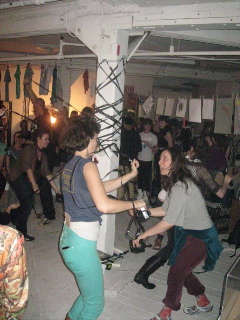
Levi: That what’s always exciting about the Spring Festival–this exploration of what performance is, what dance is, what an event is even, gets really exploded open. This year I went to see Trisha Brown at Brooklyn Academy of Music and then I went to Market by AUNTS. (laughter) I couldn’t think of two more opposite extremes in the dance/performance spectrum.
Megan: You were like… “I love New York!”
Levi: It was really exciting and they were both beautiful in totally different ways. I’m curious if you have any last impressions or thoughts about what things were successful for you or what things were challenging for you? What things surprised you? And a very wide question, what did you gain from the experience being on this end of the curatorial spectrum?
Will: A sense of agency as an artist. It is so valuable to learn how to produce … it’s like waiting tables, when you wait tables you realize you can send a piece of meat back if its not cooked the way you want it, you know what I mean? It’s so much information and a much more tridimensional understanding of the situation that you’re entering into as an artist. The reinventing the wheel thing-I think Movement Research could make it easier for people to start on a better leg. It’s very open-ended and I would never take that away, but we talked about creating some kind of handbook or table of contents even: things you should think about 3 months before, 2 months before, or 8 months before. Thinking about the Festival could start tomorrow and should, actually.
Michael: Or less time and more money! There’s no set thing of how it functions. Everything can always be different. It makes you feel less like a curator and more like a producer I would say. You think of curating and you think, okay, we’re just going to take things and fill in the slots of the festival. Whereas this-it’s not just filling the slots. You gotta figure out where you’re gonna have a venue, what the event is going to be. Whereas a lot of other festivals, you go and you see performances, and you have a captive audience ‘cause everybody is there for the week, and everyone wants to check out everyone else’s work. This Festival is not a festival in that sense.
Will: You have to manufacture identity, marketing, audience, you have to manufacture the entire thing… the desire, the pitch, everything.
Megan: So, yeah, it’s like the business and the marketing [of a festival]…in a crash course.
Regina: I think we had a lot of variety. Every day was different. And we could have picked a bunch of people and then had a weekend of performances where we sit in a theater and we watch nine or ten pieces.
Megan: I thought that one event that was super successful was the panel discussion that we had. It was really under attended, but it was so informative. The last ten minutes of it was when it was really started getting into the belly of the issue, and then we had to go. But it was good.
Will: I also feel that I haven’t really had time to officially process the whole Festival. I had a wedding the day after and then an audition the next day and then I was in a rehearsal process. I think I’m acting on a lot of the information instinctually at this point, but I don’t think I’m going to process or have my final impressions until…
Levi: New York doesn’t usually provide that kind of time.
Regina: I think you just summed that up right there.
Levi: That’s a really interesting and clear distinction to make about being a producer because when I experience the Festival, I always feel like the frame or the container or the context that the events are put in is so creative. And you’re not the first team of Festival curators I’ve talked to. It seems like that creativity is coming from a situation of finite resources, wanting to get something to happen, having to work with the people and the resources that you have, and it’s really rooted in concrete problem-solving.
Megan: Yea, its Tetris… in the city
Levi: What’s incredible is that it results in something that has this really inspiring openness about it.
Michael: Maybe that’s something that defines the Movement Research Festival compared to other festivals. There’s not a lot of festivals here in the U.S. the way they do in Europe.
Levi: Here they tend to be rooted around student income.
Regina: And they have a formula where you take class and watch performances, take class, watch performances…its kind of the same every year.
Will: A festival could be setting up a teepee in the woods and cooking meals for 8 days…at Storm King. That would be totally interesting…wouldn’t it?…Or, it wouldn’t…
Michael: Is the Festival the same thing as a vision quest?
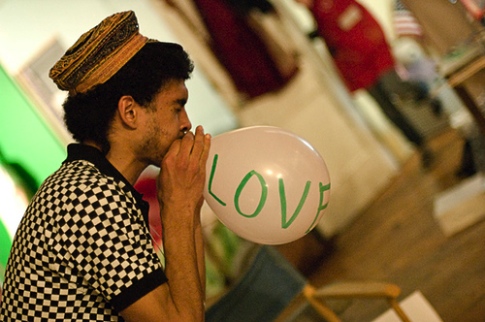
photo: Daniel Clifton



11:19 am
May 1, 2011
You can find a article about Michaël Mahalchick who participate to the exhibition Canada at Bernard Ceysson Galerie on http://blog.paris3e.fr/post/2011/04/05/La-galerie-Bernard-Ceysson-invite-la-galerie-Canada
post a comment ›